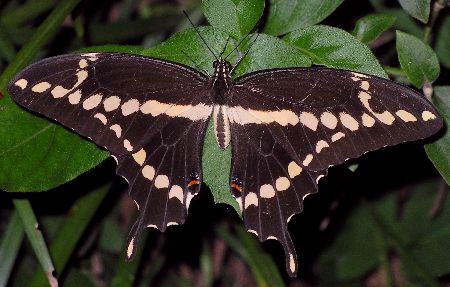by Valerie
September, 2005Giant Swallowtail Appropriately named, the giant swallowtail (Papilio cresphontes) is our largest butterfly, rivaled only by the tiger swallowtail. We frequently find giant swallowtails in our yard, where they seek refuge to roost at night. While the top sides of the wings are mostly dark brown to black with yellow markings, the undersides are more yellow. The caterpillars of the giant swallowtail are unique among this group. Most swallowtail caterpillars resemble bird droppings when they are small, but later develop stripes and/or eye spots. The giant swallowtail larvae retain the bird dropping look even when they are large. Besides the visual deception, swallowtail caterpillars have a strange appendage on their heads which can be extended if they are disturbed. This osmeterium, as it is called, is bright orange and forked. It is covered with a stongly sweet-smelling sticky substance which doesn't smell all that bad to humans. There is a good chance, though, that it is repellent to birds, spiders, or other insects. These butterfly larvae are frequently prey for a large number of predators and parasites, and they need any camouflage or other tricks in their genetic makeup to survive. It seems no accident that a head-on view of a small caterpillar looks surprisingly like a jumping spider. One main food plant for the larvae is citrus. Because they can be a nuisance on the fruit trees in commercial groves, the caterpillars are also called Orange Dogs. |